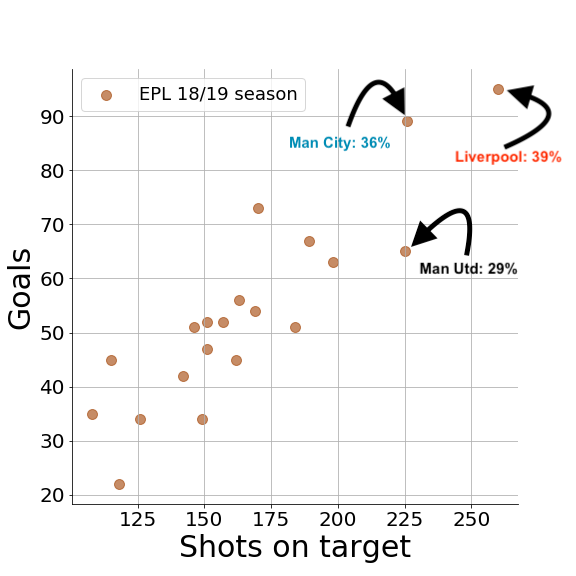
What does PK mean in soccer betting
PK in soccer betting (and in betting in general) is short for pick’em or pick. In point spread soccer betting, we speak about a PK situation when neither of the teams is favorite by the bookmaker, and the events on both sides of the bet have the same probability to happen.
Simple case
The simplest case occurs when neither of the teams is favored to win, not even by a single goal. In this case you should bet on the team that you think is favorite to win the match, regardless of the goal difference.
For example, in the table below Manchester City and Arsenal are both assigned a spread at -110, which means that betting on either of those teams to win will win you the same amount of money. You will have to bet $110 to win $100.
| Team | Odds |
|---|---|
| Manchester City | PK (-110) |
| Arsenal | PK (-110) |
In practice, an exact PK is quite rare, but you might see the PK sign on points spread lines that are very close to being equal. For example
| Team | Odds |
|---|---|
| Manchester City | PK (-115) |
| Arsenal | PK (-105) |
In this case Manchester City is slightly favored by the bookie. To win $100 you will have to bet $115, while to win 100 in case Arsenal wins, you will only have to bet $105.
In soccer, you have a third possible outcome, which is the draw. In case you have bet on either side of a PK bet, and the match ends in a draw, your bet is refunded, or pushed. This is the same as in the case of a Draw No Bet (also known as DNB).
Spread point or Handicap
A PK situation can also arise in case a spread point is applied to the bet. In soccer this is called Handicap betting. In Handicap betting, a point spread is added to each of the teams involved in the bet, and the odds are shown for the result after the point spread is added. This allows the bookmakers to balance the odds between two teams that do not have the same strength. As I am writing (21 February 2024) I am looking at the AH (Asian Handicap) odds for Liverpool-Luton. It’s an almost perfect example of PK situation
| Team | Odds (AH) |
|---|---|
| Liverpool | PK 1.94 (-1.5) |
| Luton | PK 1.92 (+1.5) |
In the situation above, Liverpool is favorite, as the bookie gives it roughly the same winning odds as Luton but after subtracting 1.5 goals from the ones scored by Liverpool. In this case we are using European decimal odds, which are most commonly used in these types of bets. We can however rewrite the odds above in American odds, just to be more clear.
| Team | American Odds (AH) |
|---|---|
| Liverpool | PK -106 (-1.5) |
| Luton | PK -108 (+1.5) |
As you see, we have to bet $106 on Liverpool to win with more than 1 goal difference, in order to win $100. Very similar amount to the $108 we would have to bet, to get on the opposite outcome (Liverpool to win with at most 1 goal difference).
Soccer Betting on PK lines
PK is very common in Asian Handicap, where you need to understand not only if a team wins but also how many goals difference will be between the two teams. You will have to come up with some prediction of the final score. This can be done by building a mathematical model that predicts the number of goals scored and conceded by both teams.
The first step to build a model is to get as much information as possible about the strength of a team, in other words some metrics and statistics about the team performance. Some information that is easy to find and valuable to build a model is the following:
- total shots
- total shots on target
- total shots conceded
- total shots on target conceded
What do we do with this information? The idea is to predict the goals that the teams will score and concede in the next match. This can be done in a few steps
Collect the data about the historical performance of all teams in the League in previous season.
This involves going back and look at previous season data, by downloading files from the internet in the best case, or manually writing down statistics from old books in the worst case. It is helpful to go as far as possible with data collection, because the more data we have the better the final model will be at predicting the future outcome of a match. Football-data is a good resource to download data from all the most important Soccer Leagues in Europe and the World.
As you can imagine, this can be a tedious work, but it can be automated using some simple programming.
Calculate the features for each season and team
Once we have the data, we need to build the features of our model. This might be simply a count of how many shots and shots on target a team has made and conceded. But it can also involve more complex manipulation of the data, like calculating average, mode and standard deviation. See an example of what the data would look like in the table below.
| Team | Total Shots 22/23 | Total Shots on target 22/23 |
|---|---|---|
| Liverpool | 234 | 138 |
| Arsenal | 209 | 154 |
| Manchester City | 222 | 144 |
| … | … | … |
It can be helpful to be creative in this phase, and apply our own knowledge of the game to come up with complex features. This is also easily automated using a programming language like Python, for example.
Compare the metrics with the actual goals scored
In this phase we try to visualize some correlation between the features we have computed above and the actual target of our model, which is the number of goals teams will score and concede in a match. An example is in the image below.

This nice plot shows how the goals scored by a team in the season correlate with the shots on target pretty well. This correlation holds for a large range of goals, even if at a low number of shots on target the variance can be higher than normal.
Visualizing those data will help us not only to build an intuition of the features that are more correlated with our target (the number of goals scored) but it will also help us to identify potential issues in our data collection and manipulation. This is an important step that should never be skipped. Python can help us in this phase too, as it has many functions and libraries that make it easy to plot our data.
Train a model to predict how many goals a team will score and concede
This is the final part. A model is essentially a tool that helps us correlate our input features (shots and shots conceded) with a target (the goals scored and conceded). The model is trained on the historical dataset of all matches (or seasons) of all teams. This will make a model learn what is the exact correlation of our input features with our target. Once the training is done the model is ready to be used. It just needs to be applied to the next match, and it will predict how many goals each team will score, with a certain confidence.
If you are interested in learning more about how to build a Soccer Betting Model, check out my books where I go into the details of how to get the data, visualize and train a model, complete with code examples.

